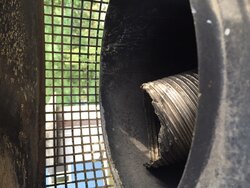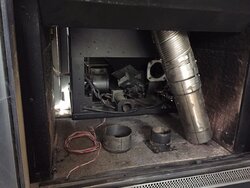Hello all,
This is my first post, allow me to introduce myself. My name is John, from central Connecticut and last fall I had a Regency Greenfire GFI55 pellet stove (insert) installed in my home. The home is a raised ranch, the stove is located on the upper level in a centrally located fireplace (not on an exterior wall) where its job is to heat roughly 1800 sq feet on the upper level. The three largest rooms have 14 foot cathedral ceilings where I'm sure much of the heat likes to be trapped. I installed a ceiling fan in one of these rooms to help circulate air, but it isn't feasible in the other 2 rooms to install fans. Last winter, a particularly cold one, we went through 5 tons of pellets. I'll also mention that I installed a thermostat for the stove and use the hi/lo setting to maintain 68 degrees. The thermostat is in an adjacent room so the stove output doesn't skew its reading of the ambient temp. On the coldest of days the oil boiler had to do some work to keep the rooms farthest from the stove comfortable but for the most part the stove performed well (we used about 275 gallons of oil in addition to the 5 tons of pellets). The home was built in 1986 and is a bit leaky. I did a lot of "homework" last year to learn how to run the stove optimally, what a proper flame should look like and how to regularly clean and maintain the stove. This spring I cleaned the steel chimney liner and found that I should have really cleaned it at least once mid burning season. The combustion fan was also very dirty and could have used a midseason cleaning.
The reason I am posting is because of how drafty the home can feel when the stove is running. It seems that it prefers to pull combustion air from around the front door and consequently that passes right over our living space where the draft can be felt. It seems an outside air kit would remedy this issue. However, as the stove is located in the middle of the home and not on an exterior wall it seems almost unfeasible. Beneath the stove is a finished room so I cannot simply route a pipe out through the basement. Is there any such outside air kit that utilizes an additional pipe up the chimney? That is the only feasible path to fresh air that I see. Would this be considered safe?
Thanks for reading.
This is my first post, allow me to introduce myself. My name is John, from central Connecticut and last fall I had a Regency Greenfire GFI55 pellet stove (insert) installed in my home. The home is a raised ranch, the stove is located on the upper level in a centrally located fireplace (not on an exterior wall) where its job is to heat roughly 1800 sq feet on the upper level. The three largest rooms have 14 foot cathedral ceilings where I'm sure much of the heat likes to be trapped. I installed a ceiling fan in one of these rooms to help circulate air, but it isn't feasible in the other 2 rooms to install fans. Last winter, a particularly cold one, we went through 5 tons of pellets. I'll also mention that I installed a thermostat for the stove and use the hi/lo setting to maintain 68 degrees. The thermostat is in an adjacent room so the stove output doesn't skew its reading of the ambient temp. On the coldest of days the oil boiler had to do some work to keep the rooms farthest from the stove comfortable but for the most part the stove performed well (we used about 275 gallons of oil in addition to the 5 tons of pellets). The home was built in 1986 and is a bit leaky. I did a lot of "homework" last year to learn how to run the stove optimally, what a proper flame should look like and how to regularly clean and maintain the stove. This spring I cleaned the steel chimney liner and found that I should have really cleaned it at least once mid burning season. The combustion fan was also very dirty and could have used a midseason cleaning.
The reason I am posting is because of how drafty the home can feel when the stove is running. It seems that it prefers to pull combustion air from around the front door and consequently that passes right over our living space where the draft can be felt. It seems an outside air kit would remedy this issue. However, as the stove is located in the middle of the home and not on an exterior wall it seems almost unfeasible. Beneath the stove is a finished room so I cannot simply route a pipe out through the basement. Is there any such outside air kit that utilizes an additional pipe up the chimney? That is the only feasible path to fresh air that I see. Would this be considered safe?
Thanks for reading.



